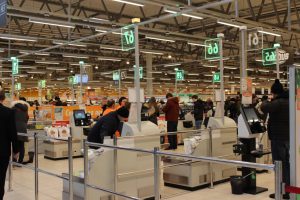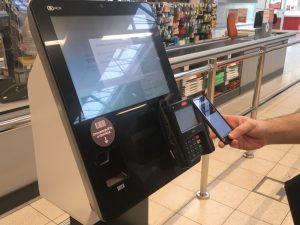Estimated reading time: 4 minutes
TSCs and VARs who maintain a big picture view of retail operations will find ways to provide self-service solutions that deliver the most significant value.
Retail self-service kiosk adoption is increasing. According to Brandessence Market Research, more businesses are gravitating toward self-service terminals, and the market will grow at a 4.8 percent CAGR to reach $38.52 billion by 2028. TSCs and VARs can capitalize on the opportunity to provide retail self-service solutions permeating nearly every market sector, from grocery to big box stores to pharmacies and specialty retail.
 You can trace the proliferation of retail self-service kiosks back to a few factors. First, consumers who wanted to maintain safe social distances when shopping preferred to checkout independently or use a kiosk instead of standing face-to-face with a store employee. Initial concerns about using a touchscreen diminished when hand sanitizer was readily available after using a kiosk.
You can trace the proliferation of retail self-service kiosks back to a few factors. First, consumers who wanted to maintain safe social distances when shopping preferred to checkout independently or use a kiosk instead of standing face-to-face with a store employee. Initial concerns about using a touchscreen diminished when hand sanitizer was readily available after using a kiosk.
Additionally, consumers became more accustomed to interacting with retailers on digital channels throughout 2020, but many still prefer in-store shopping experiences. Kiosks provide the right mix of technology and brick-and-mortar service so lines are shorter and shoppers are more engaged. They can look, touch and try the products but still exercise control over the process by completing transactions or checking to see if an item is in stock or on sale. In fact, this technology is so popular that 90 percent of consumers now use retail self-service, according to Cantaloupe.
From a retail point of view, kiosks can perform or manage many basic tasks, freeing employees to focus on higher-value work and covering gaps created by the labor shortage.
 Retail Self-Service Use Cases
Retail Self-Service Use Cases
Some of the most common ways that retailers provide conveniences to their customers with self-service kiosks include:
- Endless aisle solutions. Kiosks that allow customers to browse all available inventory from a retailer – not just what’s in stock at the location where they’re shopping – save shoppers time tracking down the items they want and can increase revenues for the business.
- Kiosks can eliminate waiting in busy departments like the deli or bakery at a grocery store. Customers can input their orders and complete their shopping while they wait and return for pickup.
- Price checks. Kiosks equipped with barcode scanners allow shoppers to check prices or confirm whether an item is on sale without waiting in line or searching for an employee to assist them.

- Gift registries. Stores that offer gift registries can benefit from deploying kiosks to help manage them. The kiosk allows shoppers to search and print a gift registry or send it to a smartphone. They can also order gifts for in-store pickup or delivery and pay. Kiosks can also allow shoppers to mark gifts as purchased without going through a checkout line.
- BOPIS order pickup. Buy online, pickup in-store processes are easier for retailers and their customers when shoppers check in at a kiosk when they arrive for their items. They can automatically communicate to store associates by scanning a QR code or barcode they received when they placed their order. This enables the retailer to complete a great customer experience by quickly bringing the correct order to the customer.
- Self-service kiosks with integrated payments enable shoppers to scan their items and complete payment transactions without the assistance of an associate.
 How TSCs and VARs can contribute to retail self-service success
How TSCs and VARs can contribute to retail self-service success
Total retail self-service solutions typically comprise more than software and a touchscreen. Kiosks should be equipped with all the hardware and peripherals necessary, such as integrated printers that print coupons or receipts. Integrated payments are also essential for many self-service processes; however, you need to ensure that consumers can use their preferred payment types, including credit and debit cards, contactless payments, and cash. A retailer may also require the kiosk to allow customers to use loyalty rewards and gift cards.
When retail self-service kiosks are used for checkout, TSCs and VARs also need to equip solutions with theft and fraud prevention measures, such as scales, cameras and RFID readers.
Retailers will also benefit from your expertise when choosing kiosk form factor and size to work with the available space in their store, how it will be used, ad whether it needs to be portable.
 Always take a holistic view of retail processes
Always take a holistic view of retail processes
Guiding your clients toward the best choices for deploying retail self-service solutions requires maintaining a big picture view. Kiosks rarely work alone, so the best strategy is to deploy solutions that integrate with the store’s POS system for easy management and visibility.
Additionally, make sure that your client understands the role that kiosks play in the shopper’s journey, whether it’s to optimize ordering, checkout, or price and inventory checks, and choose the right solution for that task.
Also, keep in mind that retail self-service shouldn’t wholly replace employee interaction, so help your clients strike the right balance between digital and human interaction with customers.
The goal with retail self-service kiosks – as with all retail solutions – is to provide the best customer experiences and greatest operational efficiencies. TSCs and VARs who accomplish both will be most successful in this growing space.

